


 |
September 11, 2017: Quirky Montreal and Old Montreal |
 |
September 9, 2017: A Guided Tour of Montreal |
 |
Return to the Index for Our Trip to Montreal |
Today, we will spend the day with two major activities. First, we'll visit the Montreal Museum of Fine Arts- a place Prudence and Nancy really want to see. After lunch, Fred and I will lead our group out to the Montreal Botanical Garden, where we intend to spend the afternoon.
A Morning Walk
Beginning yesterday, Prudence, Nancy, and Fred started doing a morning walk around the hotel area, and this morning they came back with some pictures they took while they were out walking.
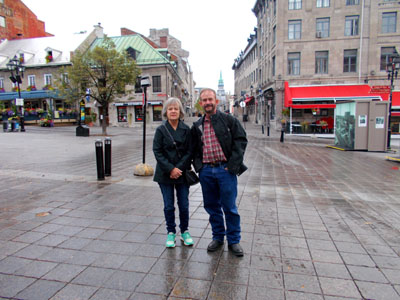 In Place Jacques-Cartier |
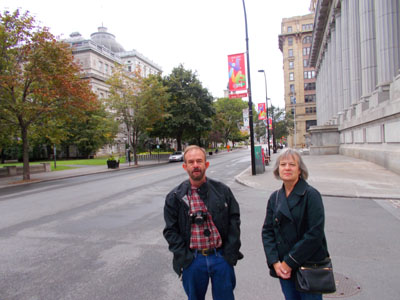 On Rue Notre Dame |
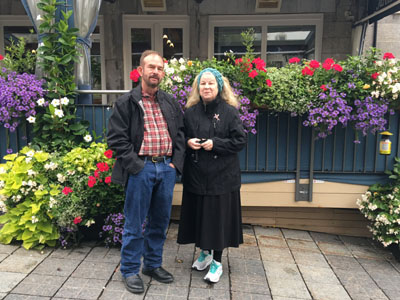 At the William Gray |
This morning, Guy wanted to go to a service at the Basilica Notre Dame, and so the group of us walked over there for the event. We'd taken an extensive tour of the building yesterday, so today was just to experience an actual service. I did make some movies there, but you have already seen them on yesterday's page, as I tried to gather together all the pictures of the basilica in one place.
On the way back from the service, I passed a little shop that seemed to be part antiques, part tourist stuff, part eclectic knickknacks. I had noticed yesterday (when the shop was closed) that for some inexplicable reason there was a bronze horse head sticking out from the stone wall underneath one of the front windows. But today, the shop is open, and the proprietor has, for some unknown reason adorned the horse head. You really should have a look.
I also got an interesting picture of the Canadian Appeals Court.
We Walk to the Museum of Fine Arts
After the church service, Prudence and Nancy wanted to return to the William Gray, so we all headed back there.
|
At the hotel, we hooked back up with Ron and Karl (who had not accompanied us to the service) and we had some discussions about how we were all going to get to the Museum. Fred and Guy wanted to walk, and so they headed off. I was going to join them, but when everyone else started opining that they would walk as well, I thought that I would walk with them and be their guide. That's how we happened to walk over in two groups.
As for the pictures that Fred and Guy took on their walk, most of those pictures were of the sculptures and other art that the two of them passed in their walk, and I'll be including those pictures in a separate section on the plethora of "public art" that is scattered around downtown Montreal. Fred did get one interesting picture of the Mary, Queen of the World Cathedral as it was overshadowed by the numerous skyscrapers that surround it.
As for our walk, we started off about 9:45, following another zig-zag route from the William Gray over to the Museum of Fine Arts. I decided to lead the group on a route different than the one Fred, Guy, and I followed yesterday, mostly so we could see some different stuff. We, too, passed a good deal of public art (my third visit to a few of the pieces, having seen them once during our bus tour and once on our walk back to the hotel yesterday); again, I am going to put all the pictures we took in a separate section (mostly so I can weed out all the duplicate pictures we all have of all these artworks). But we did take quite a few other pictures along our walk, many of which are worth including here.
|
|
|
|
|
|
|
The first half of our walk took us through the old city- from the William Gray through Plaza d'Armes and over towards the Hotel Queen Elizabeth and Place Ville Marie. But then we came to the area of downtown that is filled with new skyscrapers and the underground city below them.
|
This plaza is actually at the foot of McGill College Avenue, a broad street that begins here and runs northwest up through McGill College to the foot of Mont Royal. The plaza is above grade; there is a curved balcony with stairs down each side to the actual level of McGill College Avenue. The five us gathered at this balcony and I had an obliging passerby take a couple of pictures of us.
I actually stayed at the Queen Elizabeth Hotel back in the late 1970s, and my memories of it are such that I can see that Montreal- especially the downtown core- has grown tremendously since I was here then. The plaza on which we were standing was not here then, although Place Ville Marie was. But very few of the beautiful new skyscrapers that surrounded us were here then.
|
|
From the plaza, we descended the curved stairs down to the foot of McGill College Avenue, and then walked up that broad avenue to Sherbrooke Street, turning left there to walk the six blocks to the Museum of Fine Arts.
|
Here are more pictures that Nancy, Prudence, and I took as we walked up McGill College Avenue:
 |
When we got to the intersection with Sherbrooke Street, we turned left to head up the six blocks to the Museum of Fine Arts. Since we are walking along this broad avenue for the second time, perhaps this is a good place for all the pictures taken along it.
|
We will be on part of Sherbrooke Street East later today as it runs along the south border of the Montreal Botanical Gardens and just north of the Olympic Park. The street is named for John Coape Sherbrooke, the Governor General of British North America from 1816-18.
From the early twentieth century until the 1930s, Sherbrooke Street was the most prestigious street in Montreal. In 1912, the Montreal Museum of Fine Arts was established on Sherbrooke Street West. Later with the expansion of the city center, luxurious new houses were built a little further west in the new Garden City of Westmount.
Sherbrooke Street was extended eastward starting in the early twentieth century, and followed the urban development of Montreal in that direction. It was central to the creation of several institutions and parks such as La Fontaine Park, the Notre-Dame Hospital, Maisonneuve Park, Montreal Botanical Garden and Olympic Stadium.
|
Created and organized by the Montreal Museum of Fine Arts, the exhibition not only marked Montréal’s 375th anniversary, but also the 50th anniversary of Expo 67 and Canada’s 150th anniversary. It is showcasing 67 works of art that convey a message of peace and reflect the universal values of humanism, tolerance and openness that inspired Expo 67. You'll see some of those artworks in the section of this album devoted to Montreal's public art.
From the Montreal Museum of Fine Arts to the McCord Museum, pedestrians on Sherbrooke Street can discover 25 of these monumental sculptures from celebrated Canadian and international artists; we also passed a few of the 42 gigantic photographs by Montréal artists along this inspiring urban pathway.
Flags from close to 200 countries around the world and the 13 Canadian provinces and territorites are also displayed along Sherbrooke Street as part of the exhibition. Created by Montréal designer Claude Cormier, this spectacular installation draws inspiration from the playful and futuristic spirit of Expo67.
We enjoyed walking along Sherbrooke today (and yesterday) and about a half mile after we turned west onto it we arrived at what I thought was the Montreal Museum of Fine Arts.
The Montreal Museum of Fine Arts
The Montreal Museum of Fine Arts (Musée des beaux-arts de Montréal) is Montreal's largest museum and is among the most prominent in Canada. The museum is located on the historic Golden Square Mile stretch of Sherbrooke Street.
The Museum of Fine Arts: History and Pavilions
|
The Art Gallery at Phillips Square comprised an exhibition room, another smaller room reserved for graphic works as well as a lecture hall and an embryonic art school. The museum was enlarged in 1893. The Art Association held an annual show of works created by its members as well as a Spring Salon devoted to the works of living Canadian Artists. Gibb's gift was a watershed event in the founding of the museum's collection. The generous gift engendered keen interest and, because of it, the donations multiplied.
Too cramped at its original location, the Art Association strongly considered the idea of moving from Phillips Square to the Golden Square Mile, where the most of the city's financial elite lived at the time. They settled on the site of the abandoned Holton House, on Sherbrooke Street West, for the construction of the new museum. With the contributions of the members of the construction committee, an architectural competition was held, won by the Maxwell Brothers who proposed a building that catered to French taste of the time: sober and majestic. Work began in the summer of 1910 and what is now the Hornstein Pavilion was finished and opened in the fall of 1912.
|
In 1991, the museum's third building, designed by Moshe Safdie, was built on the south side of Sherbrooke Street. It was funded by contributions from governments and the members of the business community. Safdie's architectural design incorporated the facade of New Sherbrooke Apartments, an apartment-hotel that had occupied the site since 1905. The actual museum entry was moved across the street to the new pavilion that same year.
|
The fifth and newest Pavilion is the Michal and Renata Hornstein Pavilion for Peace, an addition to the southeast end of the Desmarais Pavilion. It opened in late 2016, and was said to have signalled the start of Montreal’s 375th anniversary celebrations, and was the first legacy project for that celebration.
The museum is today partitioned into five pavilions: the original 1912 Beaux Arts building (Hornstein Pavilion), the new Safdie-designed main entrance Desmaris Pavilion across Sherbrooke, the Stewart Pavilion behind the Hornstein, the Bourgie Pavilion across the Avenue du Museé (see below), and the recently inaugurated Hornstein Pavilion for Peace, built adjacent to and just south of the Desmarais Pavilion. Entry to all five pavilions is through the Desmaris Pavilion, and all five are connected via underground passageways.
The Desmarais Pavilion houses modern and contemporary art collection while the original Hornstein's focus is specifically archaeology and ancient art. The Stewart is devoted to decorative arts and design, and the Claire and Marc Bourgie Pavilion now houses the museums extensive collection of Canadian Art. Finally, the new Michal and Renata Hornstein Pavilion for Peace is the home for the museum's international art collection and its collection of Old Masters.
The Claire and Marc Bourgie Pavilion: Canadian Art
|
|
|
Guy and I started on the top floor and worked our way all the way down to the passageway level looking at the various eras of Canadian Art. I took pictures of works that I thought were interesting in one way or another, and I have put the best of those pictures in the slideshow at right. Go from one slide to the next using the little arrows in the lower corners of each one, and track your progress with the index numbers in the upper left. I hope you enjoy looking at some of the artworks from the Bourgie Pavilion!
The Stewart Pavilion: Decorative Arts and Design
Eye-dazzling, provocative, elegant and playful. These are just some of the words that have been used to describe the Museum’s installation of decorative arts and design, which was unveiled in 2012. The galleries showcase 900 objects– furniture, glass, silver, textiles, ceramics and industrial design– from many different countries on display.
|
|
|
The Jean-Noel Desmarais Pavilion: Temporary Exhibitions
Lamarre, Director of the MFA, was trying to interest his friend, Desmarais, in getting involved with the expansion of the museum. would continue working on his friend Paul Desmarais, asking him for help in kick-starting expansion of the Montreal Museum of Fine Arts. “A museum that is operating well,” he explained, “exhibits about twelve per cent of its permanent collection. Our museum has only one hundredth as much as the Hermitage or the Met, and yet it can exhibit barely three per cent of its collection. So Montrealers do not have access to a large part of their heritage. In other words,” concluded Lamarre, “I have the support of the governments, but I need someone to spark private donations.” And turning to Desmarais, “That’s why I need your help.”
|
|
|
The Desmarais Pavilion was inaugurated on November 21, 1991, and unanimously hailed by the critics- except for the ramped staircase leading up to the second floor galeries and down to the underground passageways. Its steps are wider than normal and the risers shorter than usual, forcing one to be careful walking on them. According to Safdie, that was intentional, “so visitors will be aware that they have entered a place where one does not walk at the same pace as on the street.” It is generally believed that the Jean-Noël Desmarais Pavilion greatly contributed to changing the Museum’s image, making it more familiar and accessible. The transparent façade is as monumental as the Maxwell brothers’ Neoclassical portico on the Hornstein across the street, but much more welcoming.
While Guy and I were in the Bourgie and Stewart Pavilions, Prudence, Nancy, and Fred were wandering through the temporary exhibition spaces in the Desmarais. Later on, I walked through the Desmarais on my way to the new Hornstein Pavilion, and I took a couple of pictures, but almost all the pictures in this pavilion were taken by Fred, Prudence, and Nancy. I have put many of these into another slideshow (above, right). As usual, move from one picture to the next using the arrows in the lower corners, and track your progress with the index numbers in the upper left.
The Michal and Renata Hornstein Pavilion for Peace: Old Masters/International Art
|
|
|
The new Hornstein focuses on art through the ages, via some 750 works, from the Middle Ages to today. There are works by Tintoretto, El Greco, Brueghel, Rembrandt, Gainsborough, Tissot, Monet, Rodin, Matisse, Miró, Picasso, and many others are represented, as much of the museum's collection is rotated through this Pavilion. It is the only collection of its kind in Quebec and the second largest in Canada, it has been enhanced by some outstanding loans from private collections.
The Michal and Renata Hornstein Pavilion was named in honour of these generous Montreal patrons who survived the Holocaust. Major Quebec and Canadian philanthropists, they made the exceptional gift to the Museum of one hundred Old Master paintings, which considerably enriched its collection of international art. It is the largest private donation made to a Quebec museum in modern history.
Creations by contemporary artists have been installed throughout the pavilion, providing a very interesting counterpoint to the Old Masters. The design of the Pavilion opens it up onto the city and its architectural heritage, offering visitors panoramic views of the city, the river, and the mountain.
We had all decided to spend about two hours here in the museum; we ended up staying here about a half-hour more. At our generally agreed time, we began to gather back in the lobby. I actually got back to our meeting point ahead of everyone else, and decided to relax for a while before we headed out to the Botanical Garden. We left the museum and walked down to Peel Street and then turned north to walk to the nearest Metro station. We bought our tickets and then walked down to the platform to await the next train to the Pius IX station a block from the Botanical Garden.
The Montreal Botanical Garden
While all seven of us made the trip out to the Botanical Garden, and while we all walked up the street from the Metro station to the entrance to the Garden, only Prudence, Nancy, Fred, Guy, and myself actually went into the Garden. Ron and Karl decided that they didn't want to walk as much as we would be doing, so they went back to the Metro station and back to the William Gray.
About the Montreal Botanical Garden
|
The botanical garden contains a greenhouse complex full of plants from around the world, and a number of large outdoor gardens, each with a specific theme. The outdoor gardens are bare and covered with snow from about November until about April, but the greenhouses are open to visitors year round, hosting the annual "Butterflies Go Free" exhibit from February to April.
The garden was founded by the mayor of Montreal in 1931, in the height of the Great Depression; the grounds were designed by Henry Teuscher, while the Art Deco style administration building was designed by architect Lucien F. Kéroack.
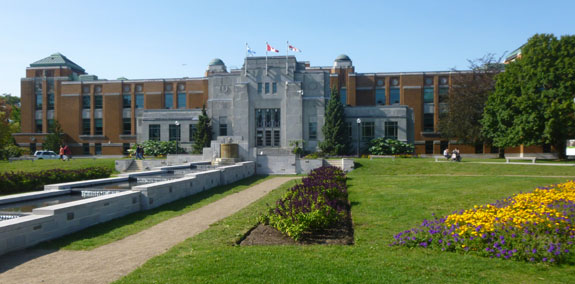 The Botanical Garden Administration Building |
In addition to providing an oasis in the city, the Botanical Garden also serves to educate the public in general and students of horticulture in particular, as well as to conserve endangered plant species. The grounds are also home to a botanical research institution, to the Société d'astronomie de Montréal, and to the Montreal Insectarium (which we did not visit this time, but which Fred and I visited in 2008).
The Reception Garden and Lunch
|

(Click on Thumbnails to View) |
When Fred and I were here years ago, we were here in the summer, and there was quite a lot in bloom. Today, in early September, most of the flowers were well past their prime, and it turned out that the Reception Garden had some of the best displays of color.
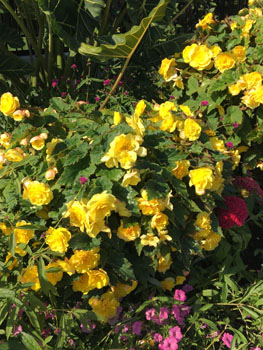 |
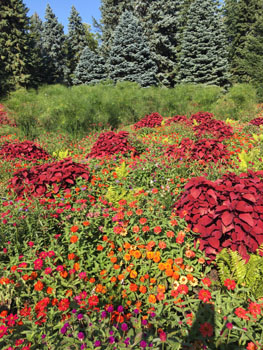 |
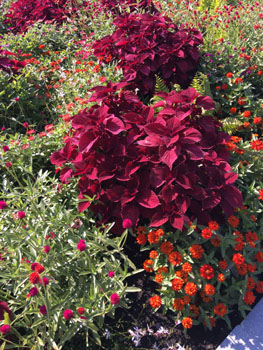 |
The history of the Olympic Stadium and its tower is an interesting one, and goes back to the late 1960s when Montreal was granted an expansion baseball franchise. Since Montreal can have very cold weather in April, September and October, a covered stadium was a must. One was designed, but it was not until Montreal also obtained the 1976 Olympics that construction began. The construction was not actually completed on time, but the stadium was used for the Games.
The tower was part of the design, as cables attached to is were used to retract the flexible Kevlar roof. Design constraints kept the roof from being used during winds above 25 MPH, and other difficulties kept the system from functioning very well. As a matter of fact, the roof has only been opened about 80 times in the stadium's history. A multi-story observatory was added to the tower and it opened in 1987, accessible via a funicular that travels 873 ft along the curved tower's spine. The funicular, which stays level throughout its trip, takes 2 minutes to ascend to the observatory, which offers panoramic views north, south, and east. Both the Botanical Garden and downtown Montreal can be viewed from the observatory.
After Karl and Ron left, the five of us went to have lunch at the Garden Restaurant, and towards the end of lunch I walked over to the other side of the Administration Building to the ticket kiosk where I got tickets for the five of us to enter the Botanical Garden.
Entry and the Rose Garden
|
Created in 1976 to mark the Olympic Games, the Montréal Botanical Garden’s Rose Garden is one of the largest in North America. It covers more than 15 acres and features close to 10,000 rose bushes, representing more than 900 species and cultivars, laid out in about a hundred different beds. The Rose Garden is divided into two main sections, illustrating the history and development of roses. The ornamental section, laid out like a river of roses flowing around small islands of trees and shrubs, contains modern bush and climbing roses. The other section showcases collections of species and shrub roses, some of them old garden roses and others modern varieties. The Aquatic Garden separates the two sections. Sadly, the roses were, as with most other flowers, well past their prime, but Fred was still interested in looking at (and smelling) the ones that were blooming.
There were also some interesting sculptures in this area; here are the best of our Rose Garden pictures:
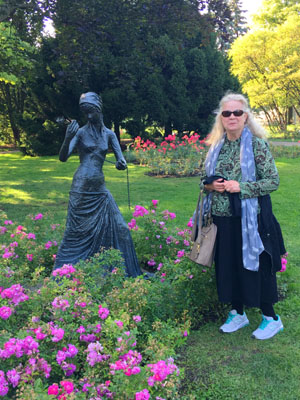 |
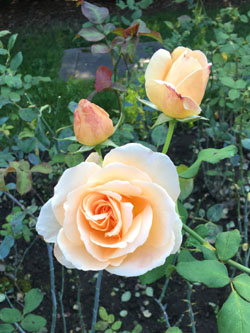 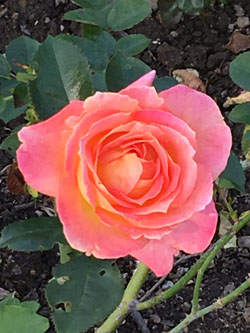
|
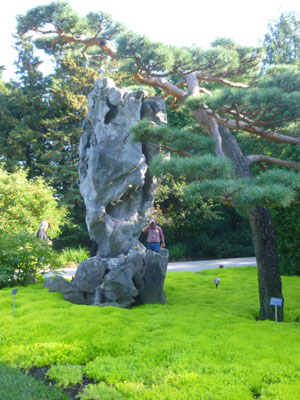 |
The Chinese Garden
|
 (Click on Thumbnails to View) |
This garden is unique. Rustic and asymmetrical at first glance, it was nonetheless created according to rigorous esthetic principles. It is both a place of contrast and harmony. The spatial organization and pavilions' architecture, the selection of plants and minerals, the water and the contrast of yin and yang are all expressions of the secular principles of the Chinese art of landscape design.
|
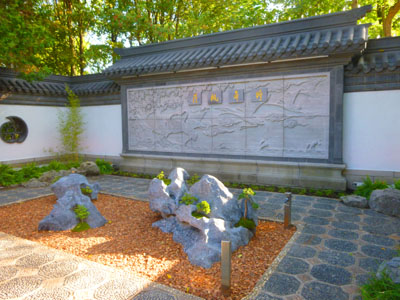 |
At that end, near the Zen garden, there was a large red Chinese gate that led into the Chinese Garden proper. Before going through it, I made a panorama of the courtyard, with our entry arch at the left and the red gate at the right:
 |
From the outer courtyard, we came through a large red Chinese gate into the main area of the Chinese garden. You can see a view looking back towards that gate here.
|
The centerpiece of this particular garden is the lagoon right in the middle, and looking out on that lagoon is a very large Chinese pagoda; to get it all in the picture at left, I had to get as far back as possible and even then had to stitch a few separate images together. The building faced the lagoon, and visitors would typically sit on its steps and look at the amazing, colorful constructions that are situated in and around the lagoon.
The concept of the garden was the work of Le Weizhong, renowned architect and master landscaper and the director, at the time of construction during 1990-1991, of the Shanghai Institute of Landscape Design and Architecture. The construction of the Chinese garden is the fruit of bonds forged between the Parks Department of the City of Shanghai and the Montréal Botanical Garden. The thousands of pieces of material needed to build the garden were shipped from Shanghai to Montréal in some 120 containers. It took 50 Chinese craftsmen to assemble them all in 1990.
The Chinese Garden is constructed along the traditional lines for a Ming Dynasty Chinese garden. Covering 2.5 hectares, it has many winding paths, an artificial mountain, and a building in the Chinese style housing a collection of bonsai and penjing that have been donated. The garden is populated with Chinese plants. The garden was constructed from 1990-1991 by 50 artisans from the Shanghai Institute of Landscape Design and Architecture, directed by Le Weizhong. The project required 120 containers of material imported from Shanghai, including 500 tonnes of stone from Lake Tai in Jiangsu province.
|
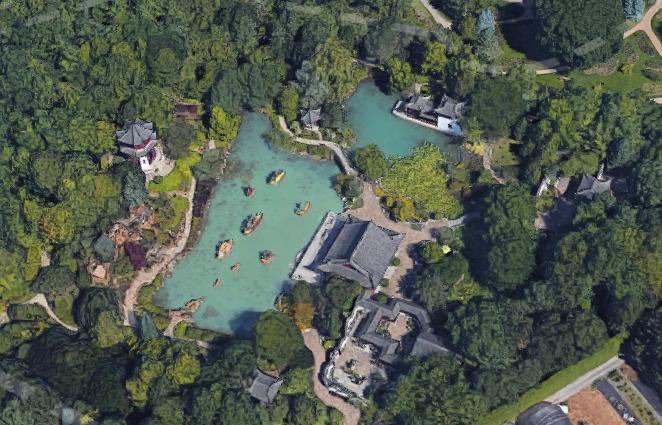 |
In that view, you can see the main pavilion in the lower right, and, if you are interested, the building in the picture above right is just north of the main pavilion across the lagoon. In that picture, you can see one of the paper dragons that adorn the lagoon. They looked like paper, but I am sure they were plastic of some kind. If they weren't, the ones in the lagoon would deteriorate quickly.
|
|
|
|
 (Click on Thumbnails to View) |
While Prudence and Nancy and Guy were wandering around inside the pavilion, Fred and I went back out into the sunshine and sat down on the railing between the pavilion and the lagoon. That's where Prudence found us.
|

(Click on Thumbnails to View) |
From the main pavilion, we headed across the footbridge that led to the other side of the lagoon. The footbridge was guarded by four paper lions, two at each end of the bridge. Just on the other side of the footbridge, we stopped to look across at the smaller pavilion across the lagoon.
|
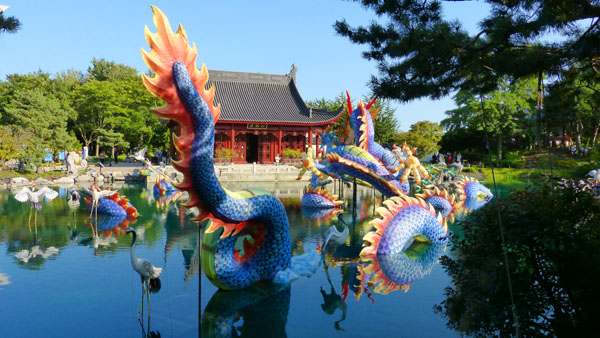 |
One feature here on this side of the lagoon was a Chinese tower, seen here from down by the side of the lagoon. While everyone else continued around the shore of the lagoon, I went up the stone stairs to go into the tower for a moment. It seemed like a place for meditation, and you can see a couple of pictures of the inside of it here and here. And here is a view of the lagoon as seen from the doorway of the tower.
|
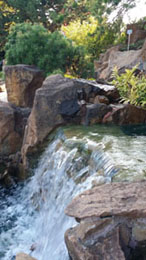 |
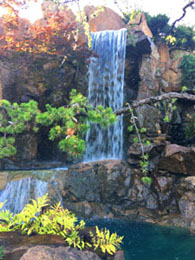 |
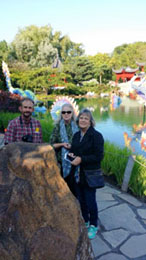 |
The waterfall was just a small one, placed for ambience and its sound. One could hear it most of the way around the lagoon, and it certainly added another dimension to the placidity of the site. The rest of the way around the lagoon along the flagstone path that followed the shore of the lagoon around towards the bonsai courtyard adjacent to the main pavilion. The shady walk was a perfect setting for some candid pictures of the group that we all took. Here are some of them:
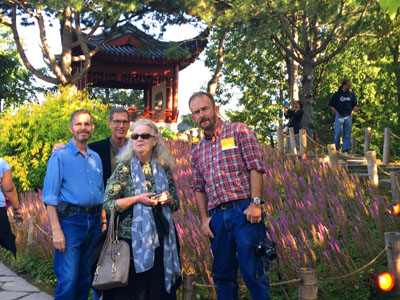 |
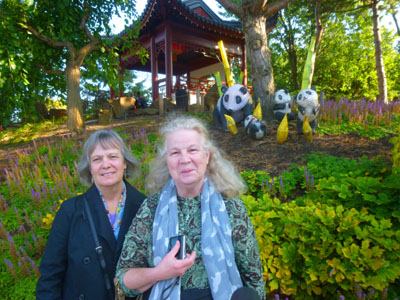 |
|
|
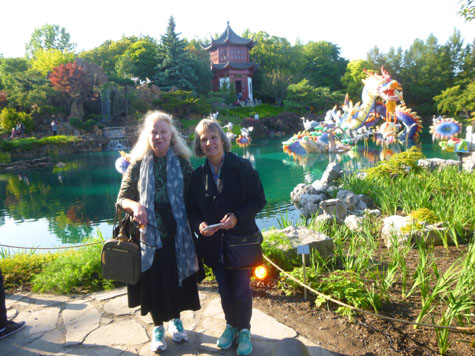
We walked back around to enter the bonsai garden that was adjacent to the main pavilion (in my aerial view above on the south side of that pavilion) so we could have a look and take some pictures.
|
  (Click on Thumbnails to View) |
Here is a panorama of the bonsai garden:
 |
From the Chinese Garden, we went back to the other side of the lagoon, via a different route that would take us back out to the Rose Garden, aiming next for the Japanese garden. On the way, we passed another Chinese Dragon.
The Japanese Garden
|
Entering a Japanese Garden is a way of returning to an environment in which people can find peace and harmony, away from the rapid pace of modern life.
In the Japanese Garden here in the Montreal Botanical Garden, we find a one-acre space where all the elements of a traditional Japanese garden are balanced to create a feeling of serenity. Each tree, each shrub, and each stone have been carefully chosen and placed.
The pathways lead the visitors through settings of peonies, rhododendrons, irises, crab-apple trees and numerous perennials- beginning here on the entrance pathway from the Rose Garden and the Chinese Garden.
Everything in this meditative place has a symbolic significance. A pond and a series of cascades and springs express life and renewal.
This contemporary garden, designed by Ken Nakajima, is inspired by the traditional art of Japanese landscaping. Stone, water and plants combine to produce a pure, simple environment in which every element is imbued with symbolism. Its sinuous lines create a pervading sense of harmony. The attentive care that such a garden requires is simply a way of celebrating the beauty of nature, for which the Japanese have profound respect. The Japanese Garden, created with the support of the governments of Japan, Canada and Québec, the City of Montréal and several Japanese companies, opened on June 28, 1988, with the beautiful, reflective pond as its centerpiece:

Adjacent to the pond and near the botanical garden's main walk, is a cultural pavilion. Designed by architect Hisato Hiraoka, the pavilion contains exhibition halls that showcase works of Japanese art, which are intended to be a timeless expression of the history and refinement of Japanese culture. The focal point of the pavilion is the hourly tea ritual; with its slow and precise movements, it, too, is a way of expressing the fact that the visitor has been transported to an oasis of peace and harmony where each movement is an expression of grace and beauty. Between the pavilion and the pond is a traditional prayer bell. Following the Japanese tradition, visitors can attach prayers to it using the paper provided in the pavilion.
|
While I was sitting on the dock, I took my own picture, looking across the lagoon to where everyone else was standing; you can see my picture here. While we were taking pictures of each other, Fred was photographing the lotus flowers, and a couple of his good closeups are below:
 (Click on Thumbnails to View) |
The Montréal Botanical Garden's magnificent Japanese Garden and Pavilion, which are a true reflection of Japanese art and culture, receive tens of thousands of visitors each year (pretty good, since the pavilion and garden are closed during the cold months of the year- which is basically November through early April.
|
| "A visit to the Japanese Garden requires an open mind and spirit. Visitors should go right to its heart; to meditate, to collect their thoughts, to feel and touch the beauty of the stone, water, plants and various architectural elements which make up the garden. It is a place where the slow-moving carp or "Koi" float in the shade of broad-leaved water lilies as if contemplating the sun's reflection or the rain on the multicoloured stones or even, as if they were listening to the gurgling waters, laughing as they spill over artfully arranged cascades. "Early-risers may surprise great blue Heron as well as red-winged blackbirds and other fine feathered friends at their morning toilet. Each season, like each time of day, has moments of intense beauty which wait only to be captured by lovers of art and nature." |
While we were here, we decided to circumnavigate the pond; there is a walk that goes all the way around it. On the far side of the pond from the pavilion, the walk cuts across a small part of the pond on a wooden walkway across the water. It is from this walkway that visitors can look down into the water and see the koi that live there. As we were crossing the walkway, Guy, who had hung back for the purpose, took this picture of myself, Prudence, and Nancy.
Walking Across the Arboretum
|
Just on the other side of the tunnel we came across some animal sculptures that looked like peccaries, or something like that. Then we continued along the pathway, stopping at this intersection for a group picture.
|
The entire area was sprinkled with benches inviting one to sit and relax, and I did just that while everyone else was off looking at some tree or another.
The walkway took us quite close to one of the ponds, where Guy and I sat down to have our pictures taken. Speaking of the ponds, here are the best of the many pictures we all took of the reed-and-lily-pad-covered, peaceful bodies of water:
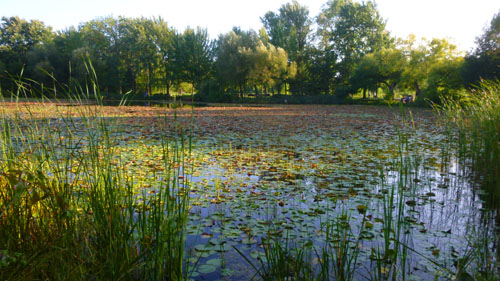 |
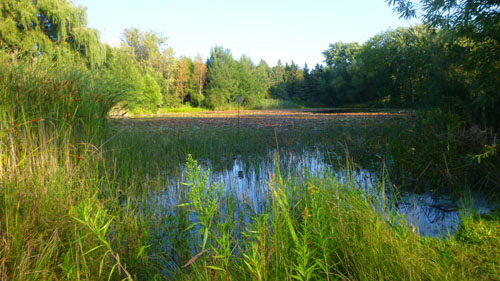 |
Eventually, we got over to the other side of the botanical garden, at the northwest end of the long area of gardens devoted to various kinds of blooming plants, specialty plants, and vegetables. That's where Fred got a quite nice picture of Prudence and Nancy.
The Specialty Gardens
|
We basically began at the north end (actually northwest) and walked back towards the entrance we came in a few hours ago, simply stopping to see anything that we thought was interesting.
We began in the Shrub Garden- rows of specimens grouped by family and genus. The varieties used for hedging, along with rockery plants, hold center stage, while a clematis collection marks the garden's southern boundary.
In the Toxic Plants Garden, we saw many wild species, as well as some ornamental plants and others used for food and medicinal purposes. These can have adverse effects on human health, some minor and others quite serious, and this garden presents a variety of potentially dangerous plants. The tiny Medicinal Plants Garden, featuring some one hundred different species, is an introduction to the vast and constantly evolving field of medicinal plants used in folk medicine and, on a larger scale, by the pharmaceutical industry.
The Monastery Garden, with its central well surrounded by symmetrical beds, was inspired by monks' gardens from medieval times. It displays a selection of medicinal and aromatic plants. The Quebec Corner is a small pocket garden of plants and small trees native to the province and its region.
The Garden of Innovations showcases new cultivars of annuals, perennials and ornamental trees and shrubs, along with the latest trends. As the Dallas Arboretum does in its test gardens, the Montreal Botanical Garden screens hundreds of hybrid plants for performance, looks, hardiness and pest and disease resistance. The plants showcased are available commercially in Quebec, and the garden changes with the seasons. It is a place for local gardeners to come and find plants they might use in their own gardens.
The last of the specialty gardens we saw this afternoon was the Useful Plants Garden. Here, we saw many plants and flowers- like blueberries, lavender, flax, goldenrod, clover and sunflowers- plants that provide food for humans and livestock, fragrances, clothing, dyes, lubricants and more. In short, they have all been closely tied in one way or another, in recent years or for millennia, to people’s everyday lives. The garden shows the wide range of plants grown for their economic utility both close to home and in other lands and times. For while many of these plants continue to be useful, some are no longer essential to people’s survival and are increasingly being transformed, and even replaced by synthetic materials.
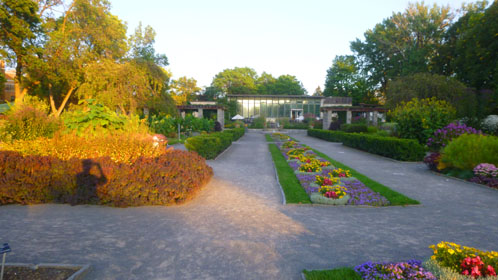 |
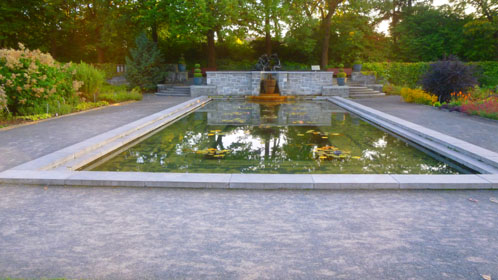 |
It would be quite a task to try to separate all the pictures we took in these gardens into those for each separate garden, and so I won't try. What I have done is to take the best of all of our pictures and put them in a couple of slideshows (as there are way too many to have you open and close each one individually). So I can make the pictures as large as possible for you, I've divided the shows by aspect ratio into two shows.
|
|
Our visit to the Botanical Garden came to an end late in the afternoon, and we headed back out the main entrance. On the way back to the Pius-IX Boulevard metro station, we passed by the ccorner of Pie-IX Blvd. and Sherbrooke St. There, we saw something we'd missed on our way up to the gardens.
|
The work is actually titled: "Le contour des conifères dans la nuit bleue et les étoiles derrière ma tête sont dans tes yeux" (roughly translated: The outline of conifers in the blue night and the stars behind my head are in your eyes)- probably the longest title for a work of art that I can remember. Quebec City chose the work of art, by Jean-Robert Drouillard, over eight other proposals submitted in a competition. The art aims to be both noble and playful; as Drouillard said: “You might think a graffiti artist came by and added baseball jerseys” to the statues."
The gift honours the close relationship between Quebec City and Montreal; a Quebec City executive said that "It also illustrates the vitality of youth and the importance of sport. This creation is imbued with nature, history and culture: it will fit perfectly to its future environment, near the Botanical Garden and the Olympic Stadium." In 2008, Montreal gave a work of art to Quebec City. The gift, featuring 44 stainless steel chairs, was installed outside Quebec City’s Gare du Palais train and bus station.
Evening in Montreal
When we left the Botanical Garden, the five of us returned to the Pius-IX subway station to return to the William Gray Hotel. The ride back was uneventful, and we had a nice walk up the hill and through Place Vauquelin to the hotel. There, we all relaxed for a while, and met at the rooftop bar for drinks and snacks.
|
We all retired to bed later on, looking forward to a walking tour of some of Montreal's quirkier neighborhoods and locales.
You can use the links below to continue to another photo album page.
 |
September 11, 2017: Quirky Montreal and Old Montreal |
 |
September 9, 2017: A Guided Tour of Montreal |
 |
Return to the Index for Our Trip to Montreal |